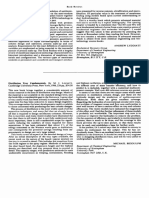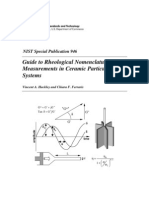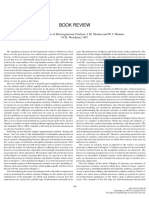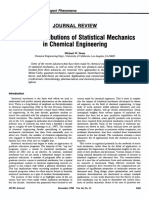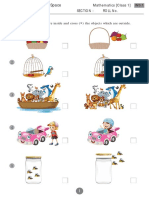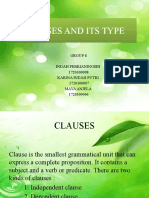Books: Fluid Flow For The Practicing Chemical Engineer
Books: Fluid Flow For The Practicing Chemical Engineer
Uploaded by
Gaby SorayaCopyright:
Available Formats
Books: Fluid Flow For The Practicing Chemical Engineer
Books: Fluid Flow For The Practicing Chemical Engineer
Uploaded by
Gaby SorayaOriginal Title
Copyright
Available Formats
Share this document
Did you find this document useful?
Is this content inappropriate?
Copyright:
Available Formats
Books: Fluid Flow For The Practicing Chemical Engineer
Books: Fluid Flow For The Practicing Chemical Engineer
Uploaded by
Gaby SorayaCopyright:
Available Formats
Books
Fluid Flow for the numerical methods (including computing), economics and
Practicing Chemical Engineer finance, and biomedical engineering (the book includes a
James P. Abulencia and Louis Theodore, discussion of the human cardiovascular system from a fluid
John Wiley & Sons, Hoboken, NJ, 600 pages, $110, flow perspective). A final chapter presents open-ended prob-
July 2009, ISBN: 978-0-470-31763-1 lems — describing approaches to situations for which there
Fluid flow and fluid mechanics have is usually no unique solution.
been covered in many books, but Two subjects of industrial importance that I would
only a handful deal specifically with have liked the authors to have included are slurry flow and
fluid flow in chemical engineering unsteady-state flow problems (e.g., calculation of drain time
operations. This book is one of those. of a liquid flowing by gravity from a vessel through piping,
The book’s first section estab- and calculation of discharge time of a gas from a pressure
lishes a foundation in the technology. vessel to the atmosphere).
Opening chapters provide a history This book provides many examples, and each chapter
of chemical engineering fluid flow, offers references (although many are relatively old). These
terms and definitions, and a discus- supplements enhance the usefulness of the volume, which
sion of transport phenomena versus should be a valuable textbook for an undergraduate course
unit operations. Introductory material on fluid flow and fluid mechanics for chemical engineers.
on Newtonian fluids and non-Newtonian flow is rather cur- Stanley S. Grossel,
sory, but helps to instill an understanding of fluid flow equip- Process Safety and Design Consultant, Clifton, NJ
ment design and operation.
The second section covers basic laws that are germane to Wiley Guide to Chemical
all practicing engineers — including Conservation Law for Incompatibilities, 3rd Edition
Mass, Conservation Law for Energy, Conservation Law for Richard P. Pohanish and Stanley A. Greene,
Momentum, Law of Hydrostatics, and Ideal Gas Law. John E. Wiley & Sons, Hoboken, NJ, 1,100 pages, $175,
A section on fluid flow classification follows, cover- Aug. 2009, ISBN: 978-0-470-38763-4
ing topics such as fluid flow mechanics, laminar flow, and Identifying chemical reactivity
turbulent flow. A chapter on two-phase flow is limited in hazards and managing them prop-
scope; there is no discussion of flow in vertical piping or erly is a key part of the job of every
flow regime maps, which are important in industrial practice. chemist and chemical engineer.
Hopefully, the authors will correct this in the next edition. These hazards may arise in the form
Fluid flow transport and applications — including prime of unstable chemicals, unintentional
movers (fans, pumps, and compressors), valves and fittings, mixing of incompatible chemicals,
flow measurement, and ventilation — are well-covered in and intended chemical reactions that
the book’s next portion. Examples illustrate how the con- get out of control. The new third edi-
cepts discussed in the prior chapters are applied. tion of “The Wiley Guide to Chemi-
Another section on fluid-particle applications deals cal Incompatibilities” is a good
primarily with theory, with little information provided on reference for practitioners involved
equipment. Chapters are devoted to particle dynamics, in the former two categories.
sedimentation, centrifugation, flotation, porous media and This updated and expanded reference compiles
packed beds, fluidization, and filtration. chemical reactivity data for more than 11,000 compounds,
The book also highlights seven topics that the Accredi- including 9,000 incompatibility profiles — significantly
tation Board for Engineering and Technology (ABET) has more data than are available from any other source. Chemi-
recently indicated should be included in any engineering cals are listed in alphabetical order by a variety of names,
curriculum. These topics include environmental manage- including IUPAC name, common names, and trade names.
ment and accident and emergency management. In these This approach generally enables the user to find data for
discussions, I felt that more information on fluid flow appli- the chemical in question, although not quite as easily as the
cations in process safety should have been included (e.g., somewhat less comprehensive but well-indexed “Brether-
calculation of pressure drop in relief device vent piping). ick’s Handbook of Chemical Reactivity” (Elsevier).
Also addressed are other topics on the roster of ABET- The new Wiley Guide also lacks the structure drawings
recommended subject matter, including engineering ethics, available in the competitive work, which can be useful in
CEP December 2009 www.aiche.org/cep 49
Books
identifying the chemical being researched. BNG model gives precise guidance to chemical engineers,
A bigger drawback of this book is its title. “Chemical chemists and other scientists working in research, quality
Incompatibilities” hints that the book contains informa- control, product development, production processes, pilot
tion about hazardous chemical interactions, but it may also plant operations, and manufacturing.
suggest that it addresses other types of incompatibilities The concepts in the book have been applied to the
— such as those that might arise in chemical formulations, precipitation of inorganic materials such as silver halides
two-phase mixtures, and so on. To demonstrate the potential in the photographic industry, and to organic systems such
confusion, a Google search on “reactive chemicals” does not as latexes, dyes, and pigments. Other applications are for
identify this book. crystalline materials used as pharmaceuticals, catalysts, and
An excellent companion to “The Wiley Guide to Chemi- imaging systems for separations and surface modifications.
cal Incompatibilities” is the NOAA Chemical Reactivity The book contains information that has not been previ-
Worksheet, available as a free download at http://response. ously available, and offers a unique opportunity for the
restoration.noaa.gov/chemaids/react.html. Although not as reader to learn up-to-date principles for precision controlled
comprehensive as the Wiley book, the Worksheet provides precipitation.
data on hazardous chemical interactions of individual
chemicals and pairs of chemicals, while assisting the user in Chemorheology of Polymers:
preparing a chemical interaction matrix in support of process From Fundamental Principles
design and hazard analysis. to Reactive Processing
Another useful resource is the AIChE/CCPS book Peter J. Halley and Graeme A. George, Cambridge
“Essential Practices for Managing Chemical Reactivity University Press, New York, NY, 454
Hazards” (www.aiche.org/Publications/). pages, $150,
Scott Berger June 2009, ISBN: 978-0-521-80719-7
Director, AIChE’s Industry Technology Alliances Plastics are the most diverse materials
in use today, and the increasing reliance
Precision Crystallization: Theory and on high-performance plastics demands
Practice of Controlling Crystal Size new ways of manufacturing polymers.
Ingo H. Leubner, CRC Press, Boca One way of doing this is through reac-
Raton, FL, 216 pages, $200, Sept. tive processing, the dynamics of which
2009, ISBN: 978-1-439-80674-6 place new demands on characterization,
Crystalline materials make up an esti- systems monitoring, and control of the complete manufac-
mated 80% of chemical and pharmaceu- turing process.
tical products. Yet few resources have The volume is a comprehensive resource for research-
been available to offer chemists and ers and practitioners working in reactive polymers and
product engineers practical guidance on processing. The book’s extended introduction is devoted to
achieving precision control of crystal the chemistry and physics of thermoplastics, thermosets and
size and size distribution — an impor- reactive polymers. Polymer characterization tools related to
tant factor in product applications. reactive polymer systems are then discussed in detail, with
This volume presents the tools to control crystal nucle- emphasis on techniques that can be adapted to real-time
ation — the key to controlling crystal size and size distribu- process monitoring.
tion for batch and continuous crystallizations. The core of the book focuses on the understanding and
Based on the author’s balanced nucleation and growth modeling of the flow behavior of reactive polymers (chemo-
(BNG) model, the book demonstrates how the results of rheology) — a complex subject, as it involves the chang-
the nucleation process are quantitatively related to practical ing chemistry, rheology and physical properties of reactive
experimental control values — such as reactant addition rate, polymers and the interplay among these properties.
crystal solubility, temperature, residence time, and the effect This book differs from many other texts on reactive
of ripening agents (crystal supersizing) and crystal growth polymers due to its breadth of coverage. It offers a complete
restrainers (crystal nanosizing) during nucleation. review of the practical industrial processes used for poly-
The author shows how the BNG theory predicts previ- mers, and provides insight into current chemorheological
ously unknown phenomena, and how it corrects errone- models and tools used to describe and control each process.
ous perceptions of the importance of reaction volume on The book should be useful to advanced students and
the outcome of crystal nucleation. Going beyond classical researchers, as well as industrial practitioners wishing to
nucleation theories (which often rely on guesswork), the move into the field of reactive polymer systems.
50 www.aiche.org/cep December 2009 CEP
You might also like
- Westerterp - Chemical Reactor Design and OperationDocument808 pagesWesterterp - Chemical Reactor Design and OperationNatrix2No ratings yet
- Kent and Riegel's - Handbook of Industrial Chemistry and Biotechnology 11va EdDocument1,833 pagesKent and Riegel's - Handbook of Industrial Chemistry and Biotechnology 11va Edvicearellano100% (8)
- Instrument Family QuizDocument7 pagesInstrument Family QuizMarcus RoperNo ratings yet
- Handbook of Industrial Chemistry and Biotechnolog Y: Kent and Riegel'sDocument10 pagesHandbook of Industrial Chemistry and Biotechnolog Y: Kent and Riegel'sJulián MelendrezNo ratings yet
- Sanet - ST 3030685772Document380 pagesSanet - ST 3030685772بلال بن عميرهNo ratings yet
- Fernando Concha A. Auth. Solid-Liquid Separation in The Mining Industry PDFDocument441 pagesFernando Concha A. Auth. Solid-Liquid Separation in The Mining Industry PDFBryan Diaz0% (1)
- Rural Improvement ClubDocument2 pagesRural Improvement ClubFord Mayoy90% (10)
- Gregory Moore - The Emergence of First-Order LogicDocument41 pagesGregory Moore - The Emergence of First-Order LogicJair GallegosNo ratings yet
- Chemistry For Sanitary EngineersDocument1 pageChemistry For Sanitary EngineersSofiaJabadanEspulgarNo ratings yet
- Book Reviews: Book Reviews J. Am. Chem. Soc., Vol. 121, No. 10, 1999 2339Document1 pageBook Reviews: Book Reviews J. Am. Chem. Soc., Vol. 121, No. 10, 1999 2339muhammad bachtiarNo ratings yet
- Book Rev#ws: R. BryantDocument1 pageBook Rev#ws: R. BryantAli AdnanNo ratings yet
- Mechanical Catalysis: Methods of Enzymatic, Homo-Geneous, and Heterogeneous Catalysis. by Gerhard FDocument2 pagesMechanical Catalysis: Methods of Enzymatic, Homo-Geneous, and Heterogeneous Catalysis. by Gerhard FLuis Avila OctavianoNo ratings yet
- Distillation Tray FundamentalsDocument1 pageDistillation Tray FundamentalsdonyaNo ratings yet
- PrefDocument3 pagesPrefapi-3774614No ratings yet
- The Pilot Plant Real Book: A Unique Handbook For The Chemical Process IndustryDocument2 pagesThe Pilot Plant Real Book: A Unique Handbook For The Chemical Process IndustryK sivaramNo ratings yet
- Saxena 1980Document2 pagesSaxena 1980cyrilbas16No ratings yet
- A Guide To Molecular Mechanics and QuantDocument816 pagesA Guide To Molecular Mechanics and QuantNandini GattadahalliNo ratings yet
- Book Reviews: Students 24) andDocument2 pagesBook Reviews: Students 24) andmmdNo ratings yet
- Thermodynamic Property Modeling For Chemical Process and Product Engineering Some PerspectivesDocument19 pagesThermodynamic Property Modeling For Chemical Process and Product Engineering Some PerspectivesindigoqweNo ratings yet
- Books: Efficiency and Sustainability in The Energy and Chemical IndustriesDocument1 pageBooks: Efficiency and Sustainability in The Energy and Chemical IndustriesRaul TejedaNo ratings yet
- Angewandte: ChemieDocument11 pagesAngewandte: ChemieZyuha AiniiNo ratings yet
- Soft Materials in Technology and BiologyDocument62 pagesSoft Materials in Technology and Biologyironmonkey00No ratings yet
- Chemical Engg AllDocument3 pagesChemical Engg AllSakthi SNo ratings yet
- (Patel V., (Ed.) (2012) ) Chemical Kinetics - INTEC PDFDocument354 pages(Patel V., (Ed.) (2012) ) Chemical Kinetics - INTEC PDFGeorgeisNo ratings yet
- Journal of Molecular Catalysis A: ChemicalDocument27 pagesJournal of Molecular Catalysis A: ChemicalAMANo ratings yet
- Trace Element Modelling: XIV.1. Why Are We Concerned About Trace Metals ?Document30 pagesTrace Element Modelling: XIV.1. Why Are We Concerned About Trace Metals ?thefunfundaNo ratings yet
- PrefaceDocument3 pagesPrefaceaubreypackerNo ratings yet
- Simultaneous Mass Transfer and Chemical Reactions in Engineering Science: Solution Methods and Chemical Engineering Applications - Ebook PDFDocument68 pagesSimultaneous Mass Transfer and Chemical Reactions in Engineering Science: Solution Methods and Chemical Engineering Applications - Ebook PDFprincess.royce571100% (36)
- Principles of Colloid and Surface ChemistryDocument671 pagesPrinciples of Colloid and Surface Chemistrysahil_verma_sv92100% (12)
- Spray Drying Handbook Third Edition by K Masters 687 Pages George GodwinDocument1 pageSpray Drying Handbook Third Edition by K Masters 687 Pages George Godwinduong nguyen0% (1)
- PDF Organometallic Flow Chemistry 1st Edition Timothy Noël (Eds.) DownloadDocument53 pagesPDF Organometallic Flow Chemistry 1st Edition Timothy Noël (Eds.) DownloadhasbulkaddikNo ratings yet
- BasicsDocument106 pagesBasicsraghukkkNo ratings yet
- young1991Document1 pageyoung1991KatyNo ratings yet
- Simultaneous Mass Transfer and Chemical Reactions in Engineering Science: Solution Methods and Chemical Engineering Applications Bertram K.C. ChanDocument52 pagesSimultaneous Mass Transfer and Chemical Reactions in Engineering Science: Solution Methods and Chemical Engineering Applications Bertram K.C. Changail.anderson454100% (10)
- Guide To Rheological NomenclatureDocument36 pagesGuide To Rheological NomenclatureKerem Alev ZenginoğluNo ratings yet
- Literature Review FluidizationDocument8 pagesLiterature Review Fluidizationea4hasyw100% (1)
- Aim Paper: Iiii/Sie Joinl Propulsion Speeialisi ConiereneeDocument24 pagesAim Paper: Iiii/Sie Joinl Propulsion Speeialisi Coniereneeshamoonjamshed100% (1)
- Black Mond 1997Document2 pagesBlack Mond 1997Qasim IsmailNo ratings yet
- Research Trends in Fluid DynamicsDocument18 pagesResearch Trends in Fluid DynamicsRakeshgangavatiNo ratings yet
- For U.S.: Polymer Letters EditionDocument3 pagesFor U.S.: Polymer Letters EditionJuan PozoNo ratings yet
- First Page PDFDocument1 pageFirst Page PDFsaurabh kumarNo ratings yet
- Matthews 1993Document194 pagesMatthews 1993burakoras151No ratings yet
- Reaction Engineering and CatalysisDocument3 pagesReaction Engineering and Catalysismurdanetap957100% (1)
- Publications in Brief: BooksDocument3 pagesPublications in Brief: Booksbhawanisr@gmail.comNo ratings yet
- Chapter 01Document10 pagesChapter 01DivyanshuNo ratings yet
- Life Cycle Phases of A Typical Chemical ProcessDocument1 pageLife Cycle Phases of A Typical Chemical ProcessSJNo ratings yet
- Hydraulics in Civil and Environmental EngineeringDocument3 pagesHydraulics in Civil and Environmental EngineeringDanNo ratings yet
- Scaling Chemical Processes - Practical Guides in Chemical EngineeringDocument2 pagesScaling Chemical Processes - Practical Guides in Chemical EngineeringVikin JainNo ratings yet
- Nlewis65 31 Book Review NG 38 No 1 Winter 2004 CeeDocument1 pageNlewis65 31 Book Review NG 38 No 1 Winter 2004 Ceeoloo josephNo ratings yet
- Modeling Chemical Water Quality in ReservoirsDocument8 pagesModeling Chemical Water Quality in ReservoirsRaka NugrohoNo ratings yet
- 1 SfafafDocument13 pages1 SfafaffurtmanNo ratings yet
- Werner Krauth Statistical Mechanics Algorithms and Computations Oxford Master Series in PhysicsDocument28 pagesWerner Krauth Statistical Mechanics Algorithms and Computations Oxford Master Series in PhysicsGeorge Michael Alvarado Lopez0% (1)
- Books: Nanoethics: The Ethical and Social Implications of NanotechnologyDocument1 pageBooks: Nanoethics: The Ethical and Social Implications of NanotechnologyMark Ericson Liong PrincilloNo ratings yet
- Ebook Catalytic Kinetics Chemistry and Engineering PDF Full Chapter PDFDocument67 pagesEbook Catalytic Kinetics Chemistry and Engineering PDF Full Chapter PDFserafina.rios491100% (39)
- Organic Polymer Chemistry Saunders K JDocument1 pageOrganic Polymer Chemistry Saunders K JAns QwertNo ratings yet
- Book Reviews: Engineering Approaches For Lake ManagementDocument1 pageBook Reviews: Engineering Approaches For Lake ManagementkrismanNo ratings yet
- PDF Organometallic Flow Chemistry 1St Edition Timothy Noel Eds Ebook Full ChapterDocument53 pagesPDF Organometallic Flow Chemistry 1St Edition Timothy Noel Eds Ebook Full Chaptermichael.truss877100% (2)
- Asbjorn Sen 1985Document3 pagesAsbjorn Sen 1985Davidsantiago Murillo AvilaNo ratings yet
- Chemometrics Experimental DesignDocument2 pagesChemometrics Experimental Designसैंज जेवियरNo ratings yet
- Advances in ChemEng, Vol32 - ChemEng Kinetics PDFDocument320 pagesAdvances in ChemEng, Vol32 - ChemEng Kinetics PDFliliherliantiNo ratings yet
- Chemical Reactor Analysis and Applications for the Practicing EngineerFrom EverandChemical Reactor Analysis and Applications for the Practicing EngineerNo ratings yet
- EPLAN PropertiesDocument40 pagesEPLAN Propertiesflash_90697638No ratings yet
- Q2 Handicraft 7 - 8 - Module 1 W1 2 1Document28 pagesQ2 Handicraft 7 - 8 - Module 1 W1 2 1KATHRYN ALFONSONo ratings yet
- 2014 Provenance Studies For The Oil IndustryDocument3 pages2014 Provenance Studies For The Oil IndustryTe Siem Bro LayukaNo ratings yet
- Examples of Essay OutlineDocument4 pagesExamples of Essay Outlineafibzdftzaltro100% (2)
- AI MCQ Pharma (Lec1)Document8 pagesAI MCQ Pharma (Lec1)raneemalnaamnehNo ratings yet
- Acc.. Toma CargaDocument7 pagesAcc.. Toma CargaRonald FrancoNo ratings yet
- Nandn: 1 Gate-Cy 2004 Question PaperDocument13 pagesNandn: 1 Gate-Cy 2004 Question PaperBABLI GUPTANo ratings yet
- Artificial Intelligence BasicsDocument2 pagesArtificial Intelligence BasicsDennis DubeNo ratings yet
- Fanuc Maintenance Manual - 64305enDocument570 pagesFanuc Maintenance Manual - 64305enGuiref100% (2)
- The Design and Development of An Omni-Directional Mobile Robot Oriented To An Intelligent Manufacturing SystemDocument15 pagesThe Design and Development of An Omni-Directional Mobile Robot Oriented To An Intelligent Manufacturing SystemIbrahimNo ratings yet
- Siemens A56Document45 pagesSiemens A56carlcoxNo ratings yet
- Size Chart: Bust/ChestDocument1 pageSize Chart: Bust/ChestMaria Jose TorresNo ratings yet
- CYKADocument8 pagesCYKAEdouard HalaszNo ratings yet
- IPA Chart With Sounds PDFDocument4 pagesIPA Chart With Sounds PDFInés BellesiNo ratings yet
- Diy Recycled Jewelry TutorialsDocument19 pagesDiy Recycled Jewelry Tutorialstarcisia100% (3)
- SS 72-2014 - PreviewDocument9 pagesSS 72-2014 - Previewaru100% (1)
- Chapter-1 (Colour)Document13 pagesChapter-1 (Colour)Reyanshi DhakaNo ratings yet
- Tenacity Herbicide Label 2020Document16 pagesTenacity Herbicide Label 2020Joe BlowNo ratings yet
- Clauses and Its Type Kel 8Document13 pagesClauses and Its Type Kel 8Indah100% (1)
- The Salvation of Babies Who Die John McArthurDocument30 pagesThe Salvation of Babies Who Die John McArthurevandro7129No ratings yet
- Chem 205 Lecture 0 Course PreliminariesDocument25 pagesChem 205 Lecture 0 Course PreliminariesJeric CestinaNo ratings yet
- 3BHK VILLA-Lux Report and Calculation of Lumenaire QuantitiesDocument32 pages3BHK VILLA-Lux Report and Calculation of Lumenaire Quantitiessheik hussainNo ratings yet
- GR 1Document7 pagesGR 1Lei LanzNo ratings yet
- Carrier For SimethiconeDocument18 pagesCarrier For SimethiconeDenis LlapoNo ratings yet
- Sitop Psu100m 1ac 24VDC 40a 6ep13373ba00Document3 pagesSitop Psu100m 1ac 24VDC 40a 6ep13373ba00RudimarNo ratings yet
- 007 The Real Man Bible - Cooking OnlyDocument3 pages007 The Real Man Bible - Cooking OnlyArctic CoderNo ratings yet
- CUNANAN LENS AND MIRRORS FinalDocument7 pagesCUNANAN LENS AND MIRRORS Finalvcunanan20ur0411No ratings yet












